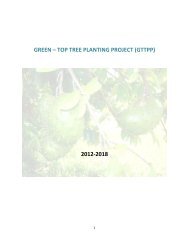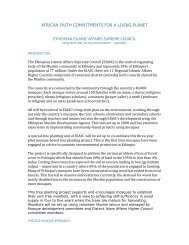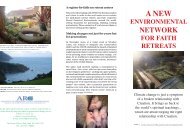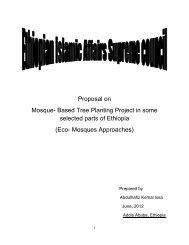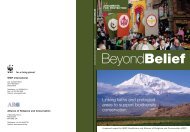summary paper - Alliance of Religions and Conservation
summary paper - Alliance of Religions and Conservation
summary paper - Alliance of Religions and Conservation
Create successful ePaper yourself
Turn your PDF publications into a flip-book with our unique Google optimized e-Paper software.
SESSION 2 The relationship between conservation <strong>and</strong><br />
development: Insights into key development <strong>and</strong> environment<br />
issues<br />
Sangha Raja Bour Krey<br />
Patriarch <strong>of</strong> Cambodia<br />
Mr President, Excellencies, Ladies <strong>and</strong> Gentlemen<br />
First <strong>of</strong> all, allow me to express my deep gratitude to the organizers <strong>of</strong> this prestigious conference in<br />
collaboration with the Ministry <strong>of</strong> Foreign Affairs <strong>of</strong> Norway, the World Bank, UNDP <strong>and</strong> the <strong>Alliance</strong> <strong>of</strong><br />
<strong>Religions</strong> <strong>and</strong> <strong>Conservation</strong> (ARC) for their kind invitations. It is a privilege <strong>and</strong> pleasure for me to<br />
address this august assembly.<br />
In the beginning, we believe, human beings lived in harmony with Mother Nature. It provided everything<br />
we needed. Then the world evolved, <strong>and</strong> this wild race towards modernization happened. The good<br />
balance <strong>of</strong> nature has toppled, creating all sorts <strong>of</strong> natural catastrophes <strong>and</strong> unprecedented ecological<br />
disasters.<br />
And despite the arrival <strong>of</strong> all sorts <strong>of</strong> technology at a speed <strong>of</strong> lightning, many lives today are lives <strong>of</strong> pain<br />
<strong>and</strong> suffering. Reduction <strong>of</strong> poverty, protection <strong>of</strong> the environment, management <strong>of</strong> natural resources,<br />
management <strong>of</strong> balanced <strong>and</strong> fair development programmes… These are issues that have never been so<br />
important, <strong>and</strong> that have never been so discussed by leaders all over the world. But are they possible<br />
I would like to remind you about our own situation, in Cambodia, where because <strong>of</strong> a terrible, secular<br />
ideology that wanted to get rid <strong>of</strong> all existing balances <strong>and</strong> harmonies, my country was made to start from<br />
nothing. They called it Year Zero.<br />
Today, after decades <strong>of</strong> war, Cambodian people are trying somehow to rebuild their society, <strong>and</strong> many<br />
have chosen to do so thanks to the Buddha’s teachings. Monks <strong>and</strong> nuns play a primary role in Khmer<br />
society, putting themselves at the service <strong>of</strong> the nation. They have actively participated in the<br />
reconstruction <strong>of</strong> the country on a macroscale, as well as on the smaller scale helping the population in<br />
their daily life.<br />
But we couldn’t have arrived at this point without the help <strong>of</strong> developed countries – which <strong>of</strong> course is why<br />
we are here in Oslo today. Thanks to the World Bank <strong>and</strong> the <strong>Alliance</strong> <strong>of</strong> <strong>Religions</strong> <strong>and</strong> <strong>Conservation</strong><br />
(ARC), several local NGOs were able to emerge through the Monastic network. These new organisations<br />
have allowed Cambodian people to become aware <strong>of</strong> the importance <strong>of</strong> education, protection <strong>of</strong> the<br />
environment, flora <strong>and</strong> fauna, the problem <strong>of</strong> deforestation. And most importantly, they enabled<br />
Cambodian people to act on these things.<br />
Why the monasteries Buddhism teaches us that all things are related: the forest provides shelter to wild<br />
animals; the wild animals protect the trees against aggression <strong>and</strong> incursion. Human beings, on their<br />
side, should also protect the forest, so that the seasons follow each other in order, thus avoiding climatic<br />
disorder.<br />
The great events relating to the existence <strong>of</strong> Lord Buddha are very eloquent in how they are all bound to<br />
nature. Prince Siddhartha was born under a tree in a grove in Lumbini which is now Nepal. He reached<br />
Awakening under a Bodhi tree in India, <strong>and</strong> his first great teaching was given in the deer park at<br />
Isipatana. Even his last moment was spent among trees: when the Blessed One lay down peacefully <strong>and</strong><br />
entered into the state that we call Maha Parinibbana – meaning total Extinction it was in the forest <strong>of</strong><br />
Kusinara.<br />
29



